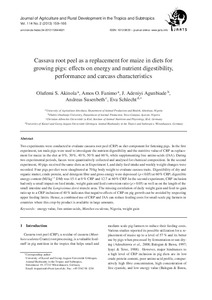Aufsatz

Cassava root peel as a replacement for maize in diets for growing pigs: effects on energy and nutrient digestibility, performance and carcass characteristics
Zusammenfassung
Two experiments were conducted to evaluate cassava root peel (CRP) as diet component for fattening pigs. In the first experiment, ten male pigs were used to investigate the nutrient digestibility and the nutritive value of CRP as replacement for maize in the diet at 0 %, 30 %, 40 %, 50 % and 60 %, while supplementing free amino acids (fAA). During two experimental periods, faeces were quantitatively collected and analysed for chemical composition. In the second experiment, 40 pigs received the same diets as in Experiment 1, and daily feed intake and weekly weight changes were recorded. Four pigs per diet were slaughtered at 70 kg body weight to evaluate carcass traits. Digestibility of dry and organic matter, crude protein, acid detergent fibre and gross energy were depressed (p<0.05) at 60 % CRP; digestible energy content (MJ kg^(−1) DM) was 15.4 at 0 % CRP and 12.7 at 60 % CRP. In the second experiment, CRP inclusion had only a small impact on feed intake, weight gain and feed conversion ratio (p>0.05) as well as on the length of the small intestine and the Longissimus dorsi muscle area. The missing correlation of daily weight gain and feed-to-gain ratio up to a CRP inclusion of 40 % indicates that negative effects of CRP on pig growth can be avoided by respecting upper feeding limits. Hence, a combined use of CRP and fAA can reduce feeding costs for small-scale pig farmers in countries where this crop-by product is available in large amounts.
Zitierform
In: Journal of Agriculture and Rural Development in the Tropics and Subtropics. Kassel : Kassel University Press. - Vol. 114, No. 2 (2013), S. 159-166Sammlung(en)
Vol 114, No 2 (2013) (Journal of Agriculture and Rural Development in the Tropics and Subtropics (JARTS))Zitieren
@article{urn:nbn:de:hebis:34-2013112644621,
author={Akinola, Olufemi S. and Fanimo, Amos O. and Agunbiade, J. Adeniyi and Susenbeth, Andreas and Schlecht, Eva},
title={Cassava root peel as a replacement for maize in diets for growing pigs: effects on energy and nutrient digestibility, performance and carcass characteristics},
year={2013}
}
0500 Oax 0501 Text $btxt$2rdacontent 0502 Computermedien $bc$2rdacarrier 1100 2013$n2013 1500 1/eng 2050 ##0##urn:nbn:de:hebis:34-2013112644621 3000 Akinola, Olufemi S. 3010 Fanimo, Amos O. 3010 Agunbiade, J. Adeniyi 3010 Susenbeth, Andreas 3010 Schlecht, Eva 4000 Cassava root peel as a replacement for maize in diets for growing pigs: effects on energy and nutrient digestibility, performance and carcass characteristics / Akinola, Olufemi S. 4030 4060 Online-Ressource 4085 ##0##=u http://nbn-resolving.de/urn:nbn:de:hebis:34-2013112644621=x R 4204 \$dAufsatz 4170 7136 ##0##urn:nbn:de:hebis:34-2013112644621
<resource xsi:schemaLocation="http://datacite.org/schema/kernel-2.2 http://schema.datacite.org/meta/kernel-2.2/metadata.xsd"> 2014-02-03T12:34:54Z 2014-02-03T12:34:54Z 2013 1612-9830 urn:nbn:de:hebis:34-2013112644621 http://hdl.handle.net/123456789/2013112644621 eng Kassel University Press Urheberrechtlich geschützt https://rightsstatements.org/page/InC/1.0/ energy value free amino acids Manihot esculenta Nigeria weight gain 630 Cassava root peel as a replacement for maize in diets for growing pigs: effects on energy and nutrient digestibility, performance and carcass characteristics Aufsatz Two experiments were conducted to evaluate cassava root peel (CRP) as diet component for fattening pigs. In the first experiment, ten male pigs were used to investigate the nutrient digestibility and the nutritive value of CRP as replacement for maize in the diet at 0 %, 30 %, 40 %, 50 % and 60 %, while supplementing free amino acids (fAA). During two experimental periods, faeces were quantitatively collected and analysed for chemical composition. In the second experiment, 40 pigs received the same diets as in Experiment 1, and daily feed intake and weekly weight changes were recorded. Four pigs per diet were slaughtered at 70 kg body weight to evaluate carcass traits. Digestibility of dry and organic matter, crude protein, acid detergent fibre and gross energy were depressed (p<0.05) at 60 % CRP; digestible energy content (MJ kg^(−1) DM) was 15.4 at 0 % CRP and 12.7 at 60 % CRP. In the second experiment, CRP inclusion had only a small impact on feed intake, weight gain and feed conversion ratio (p>0.05) as well as on the length of the small intestine and the Longissimus dorsi muscle area. The missing correlation of daily weight gain and feed-to-gain ratio up to a CRP inclusion of 40 % indicates that negative effects of CRP on pig growth can be avoided by respecting upper feeding limits. Hence, a combined use of CRP and fAA can reduce feeding costs for small-scale pig farmers in countries where this crop-by product is available in large amounts. open access In: Journal of Agriculture and Rural Development in the Tropics and Subtropics. Kassel : Kassel University Press. - Vol. 114, No. 2 (2013), S. 159-166 Akinola, Olufemi S. Fanimo, Amos O. Agunbiade, J. Adeniyi Susenbeth, Andreas Schlecht, Eva Gedruckte Ausg. im Verlag Kassel Univ. Press (www.upress.uni-kassel.de) erschienen. </resource>
Die folgenden Lizenzbestimmungen sind mit dieser Ressource verbunden:
Urheberrechtlich geschützt

